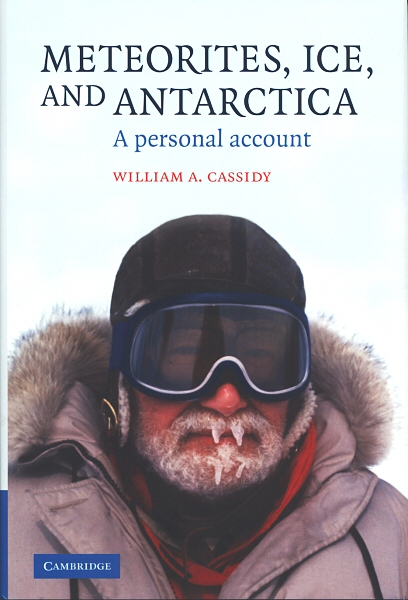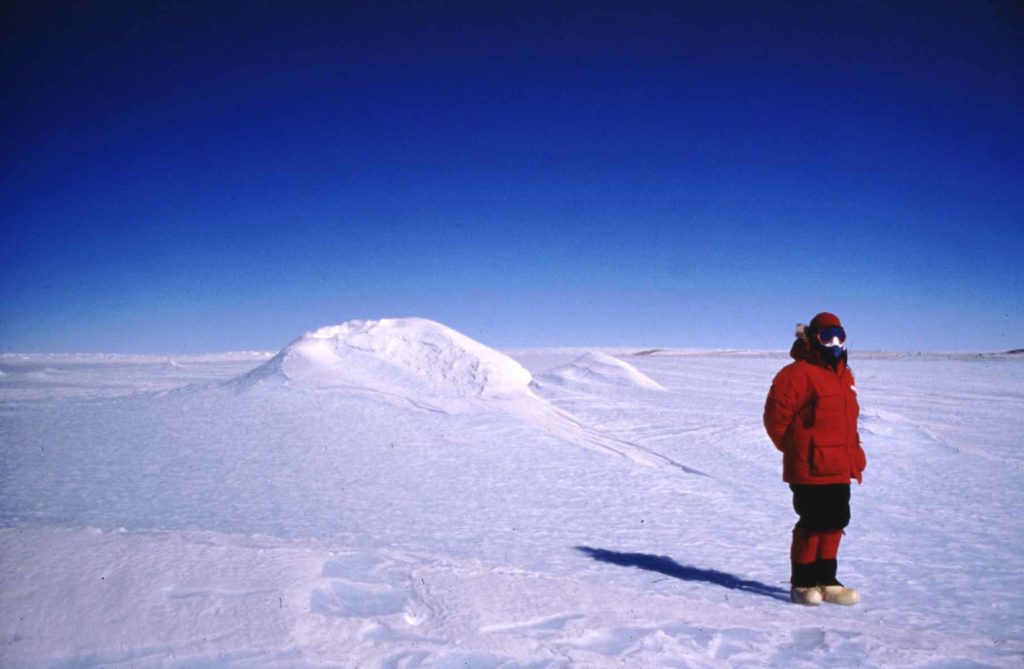And then I wrote… Last month in this space I ran a number of book reviews. I was planning to go back to more of them later in the year, but with the recent death (March 22) of Bill Cassidy, the man who founded the Antarctic Search for Meteorites program, I thought it would be timely to run here a copy of the review I wrote in 2003 of his classic book on Antarctic Meteorite hunting.
 Oddly enough, this article was not listed in my own personal bibliography and so it took a bit of looking to figure if and where it actually was published. From the internal evidence I figured out that it had been written for the late, lamented Meteorite! Magazine but since that went out of business many years back, it doesn’t have a convenient web site to check. Fortunately, among the past editors were our own Larry and Nancy Lebofsky. They looked through their back issues and discovered that it had appeared there in November, 2003.)
Oddly enough, this article was not listed in my own personal bibliography and so it took a bit of looking to figure if and where it actually was published. From the internal evidence I figured out that it had been written for the late, lamented Meteorite! Magazine but since that went out of business many years back, it doesn’t have a convenient web site to check. Fortunately, among the past editors were our own Larry and Nancy Lebofsky. They looked through their back issues and discovered that it had appeared there in November, 2003.)
Book Review: Meteorites, Ice, and Antarctica, A Personal Account, by William A. Cassidy, 2003 Cambridge University Press (ISBN 0-521-25872-3) 349 pp, with index.
You’d expect a personal account of hunting meteorites in Antarctica, written by the genial American scientist who founded the NSF-sponsored ANSMET (Antarctic Search for Meteorites) program back in 1976, to be filled with good stories and firsthand history. A book with that alone would have been an easy tale to write (as I did myself, describing my 1996 ANSMET experience in the May, 1999 issue of Meteorite!). And Bill Cassidy’s book, Meteorites, Ice, and Antarctica, does have plenty of such stories. But it has much, much more: it’s also… [In order to read the rest of this post, you have to be a paid-up member of Sacred Space, and logged in as such!]
… a scientific assessment of the results of this program that is both fascinating reading for the armchair explorer, and a valuable additional to the scholarly literature.
The book is divided into three parts. The first, “Setting the Stage,” has the history and anecdotes that one would expect. Oddly, this is in many ways the least satisfying part of the book; everything in it is good, but I was wanting to read even more. How did the early meteorite searchers learn to use snowmobiles rather than exploring on foot or by air? How was the length of a typical field season (six weeks) determined? What was it like to live on the ice back in the 1970’s, and how has it changed in the last 25 years? Still, what is included here — the early seasons, and the people who all made it happen — is both worthwhile and fun reading.
The second part of the book, “Field Results and their Consequences,” concentrates not surprisingly on the most intriguing meteorites to come from Antarctica: the lunar and martian samples. It was, after all, an Antarctic sample (number 1422 in the field) that was the first meteorite ever to be firmly identified as coming from a known place elsewhere in the solar system. As Cassidy describes it, the field notes called this rock a “strange meteorite. Thin, tan-green fusion crust… interior is dark grey with numerous white to grey breccia (?) fragments…” He then goes on to say, “It was a different story at the Johnson Space Center when the sample was unwrapped and christened ALHA 81005. These people had been working with lunar samples for years and their first reaction on looking at it was that this was a lunar sample.” His subsequent description of how the rock was studied, and shown indeed to be lunar, is both thorough, clear, and sprinkled with good stories.
There’s one thing missing from this story, however — who exactly were “these people”? Who was the first one to say, “this is a piece of the Moon”? (As it happens, the story of ALH 81005’s identification as lunar is not quite as simple as Cassidy described. It’s a tangled enough tale, though, that Cassidy can be forgiven for simplifying it here.) In a book that goes out of its way to give credit where it is due, it’s surprising and a shame that more of the workers who receive the ANSMET meteorites in Houston, the work done today by people like Cecilia Satterwhite and Kathleen McBride, don’t get at least a mention by name. Cassidy does briefly mention Robbie Score’s work as director of the receiving lab at the time of her 1984 discovery of ALH 84001, but she’s in the book only by virtue of being a team member on the ice.
 Thanks to Bill Cassidy and the ANSMET program, I got to hunt for meteorites Antarctica myself in 1996, one of the great adventures of my life. [That is me. Really. Photo by fellow meteorite hunter, Sara Russell]
Thanks to Bill Cassidy and the ANSMET program, I got to hunt for meteorites Antarctica myself in 1996, one of the great adventures of my life. [That is me. Really. Photo by fellow meteorite hunter, Sara Russell]Much more to the point in this section, however, Cassidy performs a unique service by pulling together in one place an excellent summary, current to Spring 2002, of all the known Martian and Lunar meteorites, both those found in Antarctica and those recovered elsewhere (mostly the African deserts). In addition, he describes them in terms that an intelligent lay person can follow. For instance, he puts the various classes of SNCs and lunar meteorites into a broader scientific context, including a crash course on cosmochemistry and a brief but evenhanded assessment of life on Mars that starts, delightfully enough, with his memories of reading Edgar Rice Burroughs! Again his mix of science writing and story telling is balanced just right, with some wonderful insights both into the nature of these rocks and the nature of the people who study them.
But his best illustration of kinds of people who study meteorites is the unconscious, un-self-conscious, portrait he paints of William Cassidy himself.
This is brought out the most in Part III: “Has It Been Worthwhile?” His answer to this rhetorical question can be easily guessed, but branching from that he turns this section of the book into a long, thoughtful conversation that ponders topics ranging from the evolution of the asteroid belt to the motions of the ice on which those asteroidal samples have been found. To my mind, this section was the most rewarding of all, for it gave me the sense of spending time, good time, watching a playful and creative mind at work.
One of the joys of being a meteoriticist is attending meetings of fellow meteorite scientists; and such meetings tend to have two important components. The first is the formal program, where scientific results are carefully presented and carefully discussed. The second is the conversations in the hallway, or over dinner in the evening, or sitting around over a beer late into the night, putting it all into a perspective and speculating about where it all goes from here. Cassidy’s book follows much this same pattern. The formal material (especially in the second section) is the the most solid part of the book, but watching Cassidy in part three play with this material in a more speculative sense brings the entire enterprise to life.
Though we have many mutual friends and colleagues in the field of meteoritics, it happens that I have never actually met William Cassidy in person; I have only seen him at a distance, at a podium presenting scientific results at various conferences. But after reading this book, I do feel like I know the man. His personal account in Meteorites, Ice, and Antarctica embodies everything I enjoy about the field of meteoritics… the scientific puzzles, the adventure of travel and discovery, the companionship of good and gentle people. It is an experience — and a book — that I am delighted to own, to recommend, and to share.
